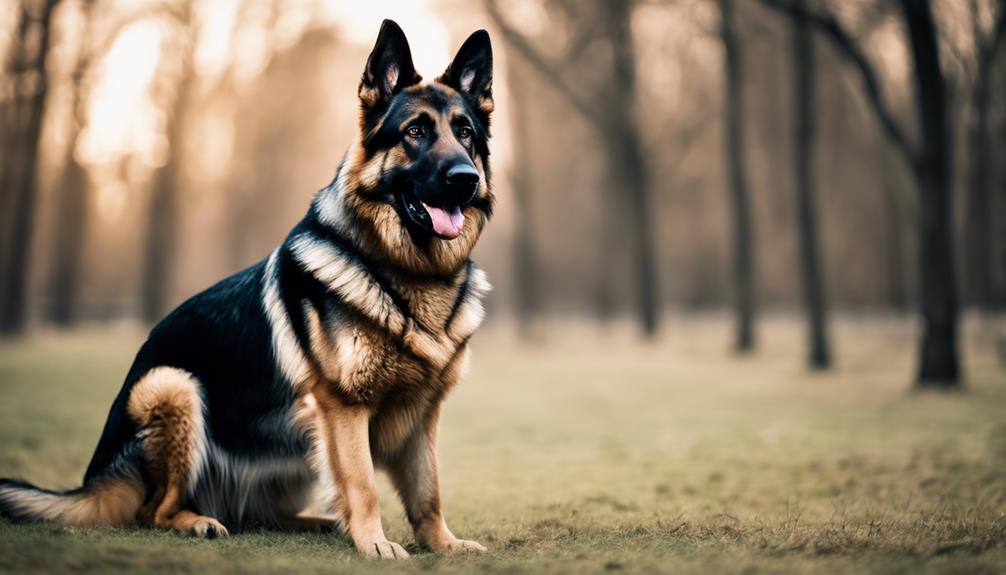🐾 Paw-some Partnership Alert! 🐾
As a pack of German Shepherd enthusiasts at MixGermanShepherd.com, we're always sniffing out the best products for our furry friends. Guess what? When you fetch something from Amazon through our links, we earn a little treat! 🦴
You may not be aware that the DDR German Shepherd breed has a fascinating history tied to a specific period in Germany. As you explore this guide, you will uncover unique insights into the characteristics and abilities that set these dogs apart. Understanding the DDR German Shepherd’s background and traits can provide valuable knowledge for prospective owners interested in welcoming this special breed into their lives.
Key Takeaways
- DDR German Shepherds originated from East Germany’s military breeding program.
- They were developed with specific traits for military and institutional roles.
- Renowned for their even-tempered nature, courage, and confidence.
- Proper care, training, and socialization are crucial for their well-being and behavior.
DDR German Shepherd Breed Overview
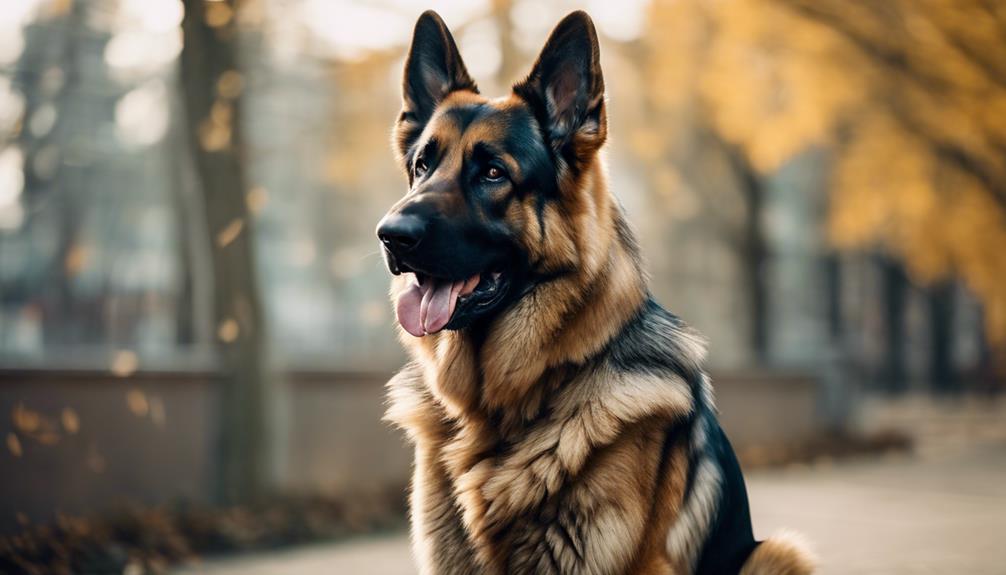
The DDR German Shepherd breed, originating from East Germany’s military breeding program, is characterized by distinctive physical features and behavioral traits. These dogs, specifically bred in the working line of German Shepherds, were developed to be versatile and robust. Their larger heads, broad shoulders, deep chests, and dark coats set them apart from other German Shepherd lines. The East German military breeding program aimed to create dogs with medium prey drive, natural guarding instincts, and a strong bond with their owners.
DDR German Shepherds are known for their traditional working dog traits, which make them suitable for various tasks. They excel in obedience, protection work, search and rescue operations, and as loyal companions. However, due to their specialized breeding history, DDR dogs require careful selection for nerve strength. This selective breeding process ensures that these dogs maintain their characteristic temperament and abilities.
Despite their origins in a military breeding program, DDR German Shepherds are not limited to working roles. They also thrive as family pets, showing loyalty, intelligence, and affection towards their owners. Their ability to adapt to different environments and tasks makes them highly sought after in various fields, from military and police work to service and therapy dog roles.
History and Origins
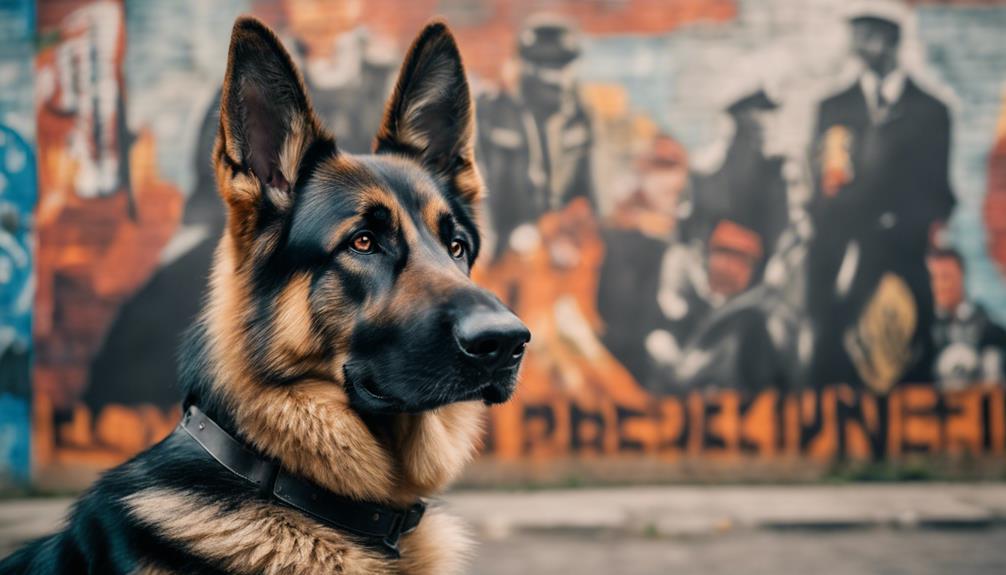
DDR German Shepherds have a significant history rooted in East Germany’s military and police breeding initiatives. The breed’s development was purposeful, aiming to create dogs with specific traits to support soldiers during the Cold War. The strict breeding standards enforced under the East German Communist regime emphasized producing robust, heavily coated canines for military and institutional roles.
Breed Development
In the development of the breed, breeders in East Germany meticulously selected and bred German Shepherds with specific traits tailored for military and institutional roles during the Cold War. These dogs were known as the East German Shepherd or DDR Shepherds, and their breeding program focused on the following aspects:
- Specific Traits: Breeders aimed to create dogs with characteristics suitable for military and police work.
- Large and Strong Build: Dogs were bred to be robust and powerful, capable of enduring harsh conditions.
- Thick Coats: The breeders prioritized thick coats to protect the dogs in various environments.
- Strict Standards: The breeding program had strict standards to ensure the dogs possessed the required working abilities for their designated roles.
Historical Significance
Breed development for the DDR German Shepherd breed in East Germany under the Communist regime entailed meticulous selection and breeding practices to tailor specific traits for military and institutional roles during the Cold War. The DDR Shepherds were specifically bred to excel in various military services, requiring dogs with exceptional strength, agility, and endurance. The breeding standards set by the East German Communist Party were stringent, focusing on producing dogs with thick coats to withstand harsh conditions. These dogs were selected and trained for their working roles, emphasizing qualities such as loyalty, protectiveness, and alertness. The historical significance of the DDR German Shepherds lies in their specialized breeding for specific tasks under the strict guidelines of the East German regime, highlighting their importance in serving the needs of the military and institutions during that era.
Physical Characteristics and Appearance
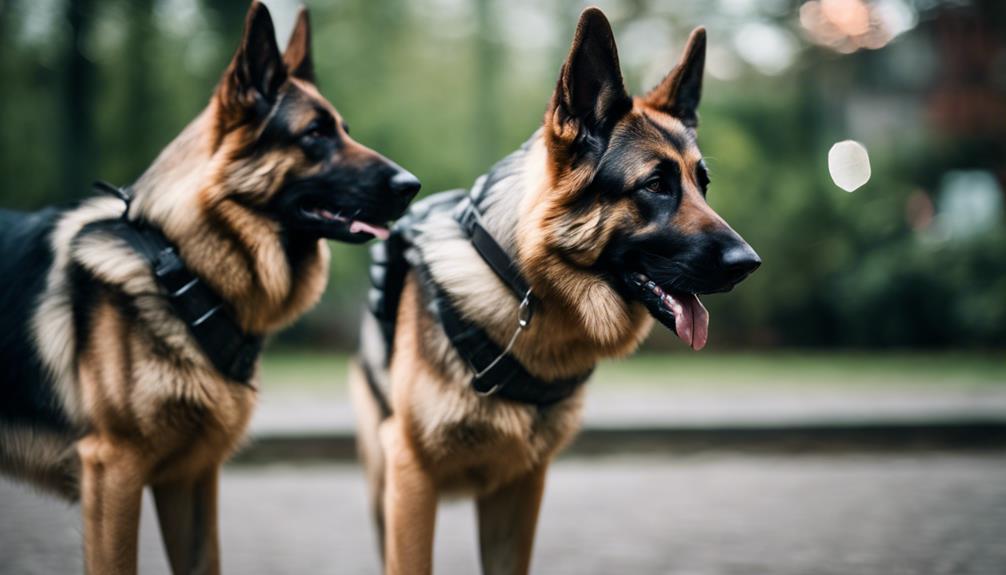
Characterized by their larger heads, broad shoulders, deep chests, and dark coats, DDR German Shepherds exhibit distinct physical features that set them apart from other breeds. These traits are a result of their breeding history and serve various functional purposes:
- Strong Build: DDR German Shepherds have robust and muscular bodies, with a powerful build that reflects their heritage as working dogs.
- Dark Coats: Their dense double coats are typically black, allowing them to blend well in various environments and providing protection from different weather conditions.
- Pronounced Head: They have a head structure that is more substantial compared to other German Shepherds, giving them a bold and alert appearance.
- Alert Expression: DDR German Shepherds are known for their keen and attentive expressions, which reflect their intelligence and natural guarding instincts.
These physical characteristics not only contribute to the imposing presence of DDR German Shepherds but also play a role in their ability to excel in various tasks. Understanding these features is crucial for individuals looking to welcome a DDR German Shepherd into their homes, as it gives insight into the breed’s unique traits and requirements.
Temperament and Behavior
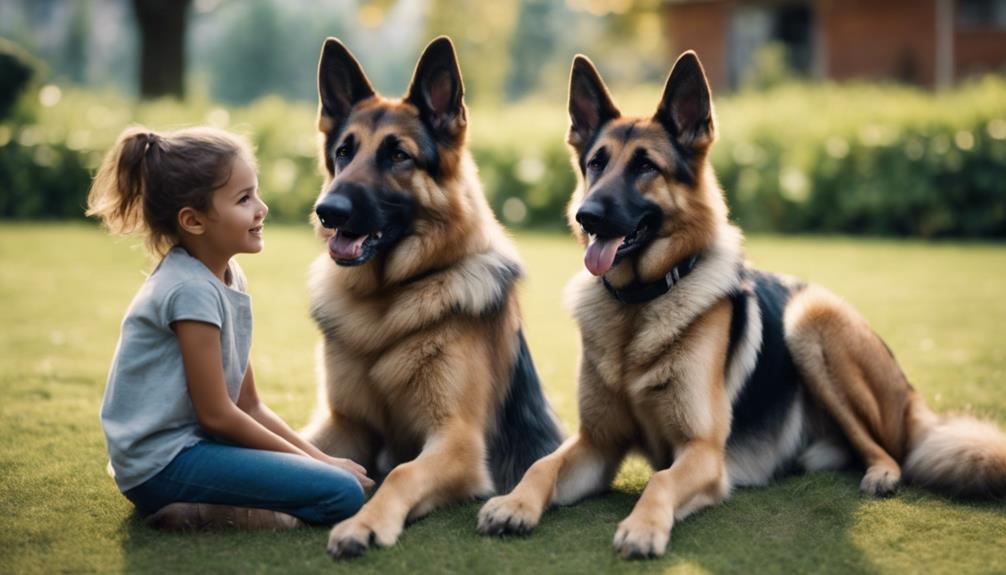
DDR German Shepherds are renowned for their even-tempered nature, courage, and confidence, which are essential traits for military and protection tasks. To ensure optimal behavior, it is crucial to provide them with proper training and socialization to manage their high energy levels and potential for aggression. Early training is vital to harness their guarding instincts effectively and foster strong bonds with their owners.
DDR GSD Temperament Traits
When considering the temperament traits of DDR German Shepherds, it is crucial to understand their innate characteristics and behavioral tendencies. DDR German Shepherds are known for being even-tempered, courageous, and confident. However, due to their protective instincts, they may exhibit aggression if not properly managed. Here are some key temperament traits to consider:
- Even-tempered nature
- Courageous and confident demeanor
- Potential for aggression if not trained adequately
- Strong protective instincts
Understanding and addressing these traits through proper training and socialization are essential for ensuring a well-balanced and well-behaved DDR German Shepherd.
Behavior Training Tips
To effectively train the behavior and temperament of DDR German Shepherds, it is imperative to establish clear boundaries and consistent reinforcement techniques. These dogs, known for their guarding instincts and loyalty, require structured training to channel their protective nature positively. Begin training early to instill good behavior habits and manage their energy levels effectively. Use positive reinforcement methods such as treats or praise to encourage desired behaviors and discourage negative ones. Incorporate regular exercise and mental stimulation into their routine to prevent boredom and potential behavioral issues. By establishing yourself as a strong leader through training, you can foster a strong bond with your DDR German Shepherd based on trust and respect, enhancing their loyalty and overall behavior.
Socialization Importance
Early and thorough socialization plays a critical role in shaping the temperament and behavior of German Shepherds bred in the DDR lineage. Proper socialization is essential for DDR German Shepherds to learn how to interact positively with people, pets, and different environments. Here are four key benefits of socialization for DDR German Shepherds:
- Socialization from a young age helps DDR Shepherds avoid aggression or fear-based behaviors.
- Proper socialization teaches DDR Shepherds effective communication skills.
- Early socialization enables DDR Shepherds to adapt well to new situations.
- Well-socialized DDR German Shepherds are more likely to be confident and adaptable in various social settings.
Training and Socialization Tips
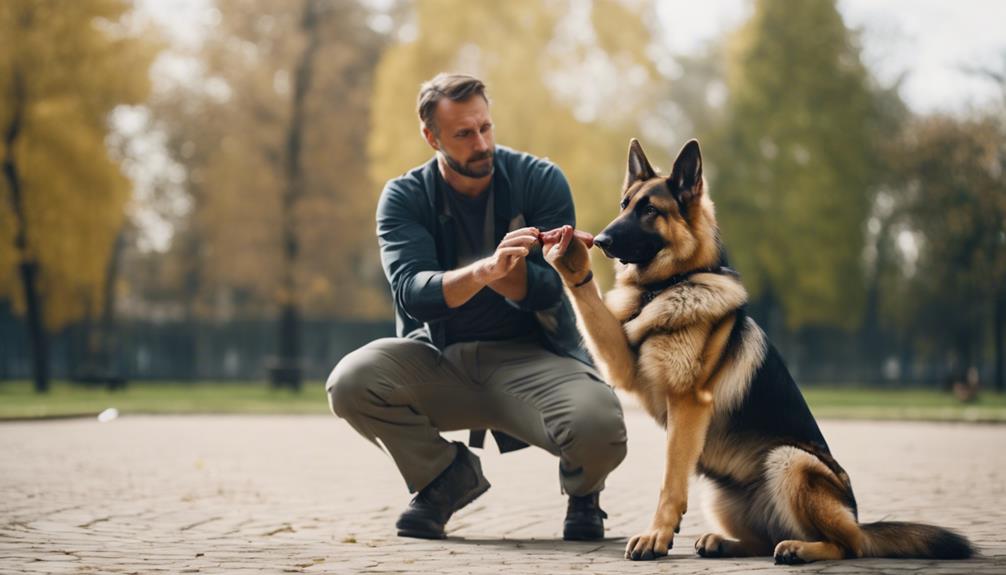
Implementing consistent positive reinforcement techniques during training is essential for shaping desired behaviors in DDR German Shepherds. Training should commence early to establish good habits and prevent behavioral issues. Positive reinforcement, such as treats, praise, or playtime, helps the German Shepherd associate desired behaviors with rewards, making learning more effective and enjoyable.
Socialization is crucial for DDR German Shepherds to interact well with people and other animals. Expose your dog to various environments, sounds, and situations from a young age to prevent fear or aggression later on. Controlled introductions to different stimuli will help your German Shepherd become a well-adjusted and confident companion.
To keep your DDR German Shepherd mentally engaged, provide interactive toys, puzzles, and training games. Mental stimulation is as important as physical exercise for this intelligent breed. Regular walks, runs, and play sessions are essential to maintain their physical health and prevent boredom.
If you encounter challenges during training or notice concerning behaviors, seek guidance from a professional dog trainer or behaviorist. They can provide tailored strategies to address specific issues and enhance your DDR German Shepherd’s training experience. Remember, patience, consistency, and positive reinforcement are key to successfully training your DDR German Shepherd.
Health and Common Conditions
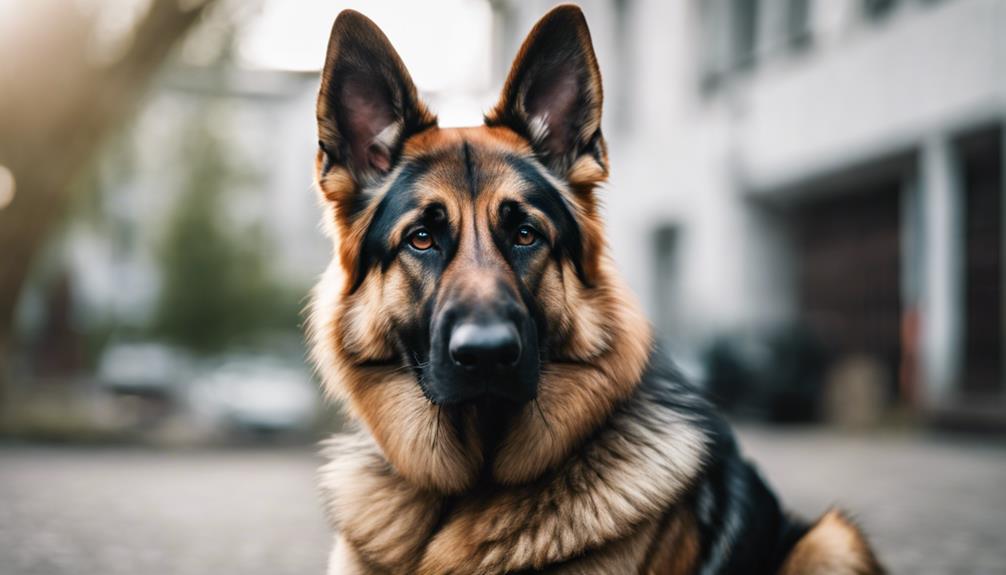
For DDR German Shepherds, maintaining optimal health is crucial given their robust genetic predisposition to lower hip dysplasia risk and overall hardiness. These dogs exhibit rock-solid nerves and robust health, thanks to historical breeding practices that have focused on minimizing the occurrence of hip dysplasia and other common conditions. Here are some key points to consider for the health and well-being of your DDR German Shepherd:
- Regular Veterinary Check-ups: Schedule routine check-ups with your veterinarian to monitor your DDR German Shepherd’s overall health and catch any potential issues early.
- Balanced Diet: Provide a balanced and nutritious diet to support your dog’s robust health and immune system.
- Exercise Requirements: Regular exercise is essential for keeping DDR German Shepherds healthy and mentally stimulated. Engage in activities that challenge them physically and mentally.
- Grooming: Regular grooming sessions not only help maintain your dog’s coat but also allow you to check for any skin issues or abnormalities that may require attention.
DDR German Shepherd Puppy Care
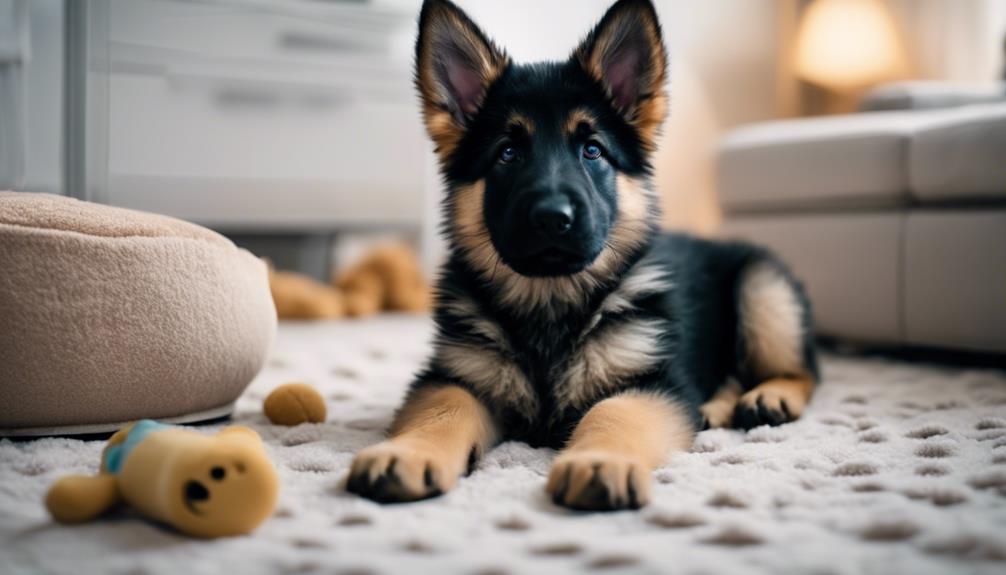
When caring for DDR German Shepherd puppies, it is crucial to provide a balanced diet tailored to their nutritional needs. Proper socialization of young Shepherds is vital to prevent behavior issues later in life. Training DDR pups early on helps establish good habits and strengthens the bond between you and your puppy.
Feeding DDR Puppies
To ensure optimal growth and health for DDR German Shepherd puppies, providing a high-quality, nutrient-rich diet in appropriate quantities is essential. Here are some key points to consider when feeding DDR Shepherd puppies:
- Establish a feeding schedule with multiple small meals throughout the day to prevent overeating.
- Ensure proper nutrition tailored to DDR Shepherd puppies’ needs to support their growth and health.
- Consult with a veterinarian or breeder for specific dietary recommendations.
- Monitor the puppy’s weight regularly and adjust the feeding plan as needed to maintain a healthy growth rate.
Socializing Young Shepherds
Establishing positive interactions and experiences early on is crucial for the proper socialization of DDR German Shepherd puppies. Socializing young shepherds during their critical developmental period helps shape their behavior and temperament as adults. Early socialization involves exposing them to various stimuli like different environments, people, and animals. This exposure helps them become well-adjusted, confident, and less likely to exhibit fear, aggression, or anxiety in the future. Positive experiences during socialization lay a solid foundation for a well-rounded and balanced DDR German Shepherd. To ensure effective socialization, consider the following key aspects:
| Aspect | Description | Importance |
|---|---|---|
| Exposure to Environments | Introduce them to different settings to build confidence | High |
| Interaction with People | Encourage positive interactions with various individuals | Essential |
| Socializing with Animals | Allow controlled interactions with other animals | Beneficial |
Training DDR Pups
For DDR German Shepherd puppies, early socialization and training are crucial steps in developing a well-rounded and obedient companion. To ensure your DDR Shepherd pup grows into a well-behaved adult, follow these training tips:
- Enroll your DDR Shepherd puppy in training classes to learn obedience and proper social skills.
- Use positive reinforcement methods, as DDR Shepherds respond well to rewards due to their high intelligence.
- Provide plenty of mental stimulation to prevent boredom, as DDR Shepherd puppies have a high energy level.
- Shape their natural guarding instincts through early training and socialization to ensure they become well-adjusted adult DDR Shepherds.
Diet and Nutrition Guidelines

How crucial is maintaining a high-quality, balanced diet for DDR German Shepherds to support their energy levels and muscle development? DDR German Shepherds require a diet rich in protein, fats, and carbohydrates to meet their energetic and muscular needs. Consistency in feeding schedules is paramount to aid in proper digestion and prevent obesity in these active dogs. Here is a breakdown of essential diet and nutrition guidelines for DDR German Shepherds:
| Nutrient | Importance |
|---|---|
| Protein | Supports muscle growth and repair, aim for a high-quality protein source. |
| Fats | Provides energy, choose healthy fats like omega-3 fatty acids. |
| Carbohydrates | Serve as a quick energy source, opt for complex carbs over simple sugars. |
In addition to a balanced diet, always ensure fresh water is readily available to keep your DDR German Shepherd hydrated. Refrain from feeding table scraps or human food, as it can disrupt their digestive system and lead to nutrient deficiencies. To tailor a diet plan specific to your DDR German Shepherd’s needs, seek guidance from a veterinarian or a canine nutritionist. By following these guidelines, you can help your DDR German Shepherd thrive with optimal nutrition.
Exercise and Activity Needs
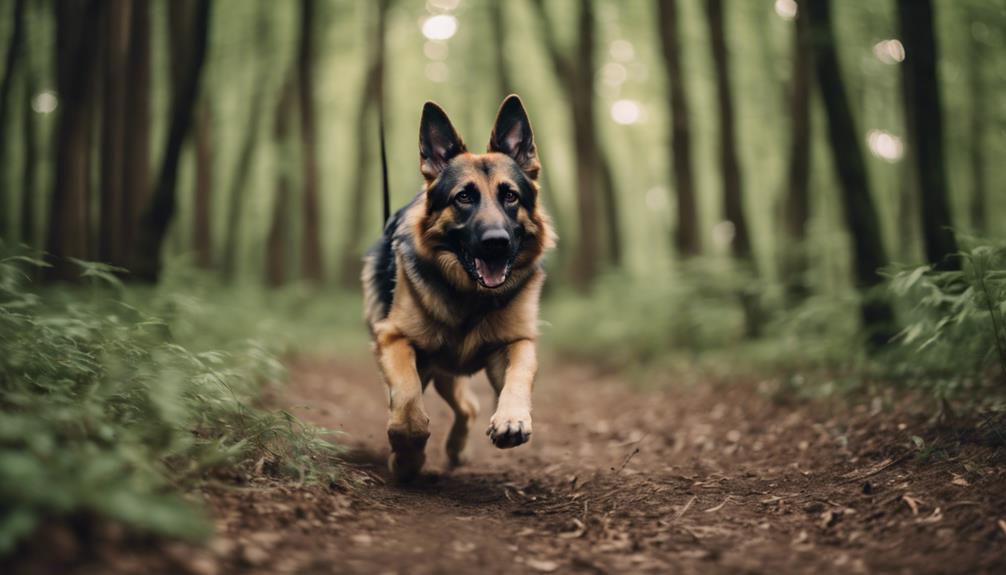
To ensure the optimal health and well-being of DDR German Shepherds, it is imperative to meet their high exercise and activity requirements consistently. DDR German Shepherds are active and intelligent dogs that thrive on physical and mental stimulation. Here are some key points to consider regarding their exercise and activity needs:
- Daily Exercise Routine: DDR German Shepherds require regular physical activities such as walks, runs, and play sessions to maintain their health and happiness. Aim for at least 1-2 hours of exercise each day to keep them active.
- Interactive Games and Training: Engaging in interactive games and training sessions not only provides physical exercise but also stimulates their minds. Consider activities like agility training, obedience exercises, or puzzle toys to keep them mentally sharp.
- Prevention of Health Issues: Regular exercise is crucial for preventing obesity, promoting muscle development, and supporting overall fitness in DDR German Shepherds. It also helps prevent behavioral issues that can arise from pent-up energy.
- Consistency is Key: Failure to meet their exercise needs can lead to behavioral problems and health issues. Consistent daily exercise and mental stimulation are vital for the well-being of DDR German Shepherds.
Grooming and Coat Maintenance
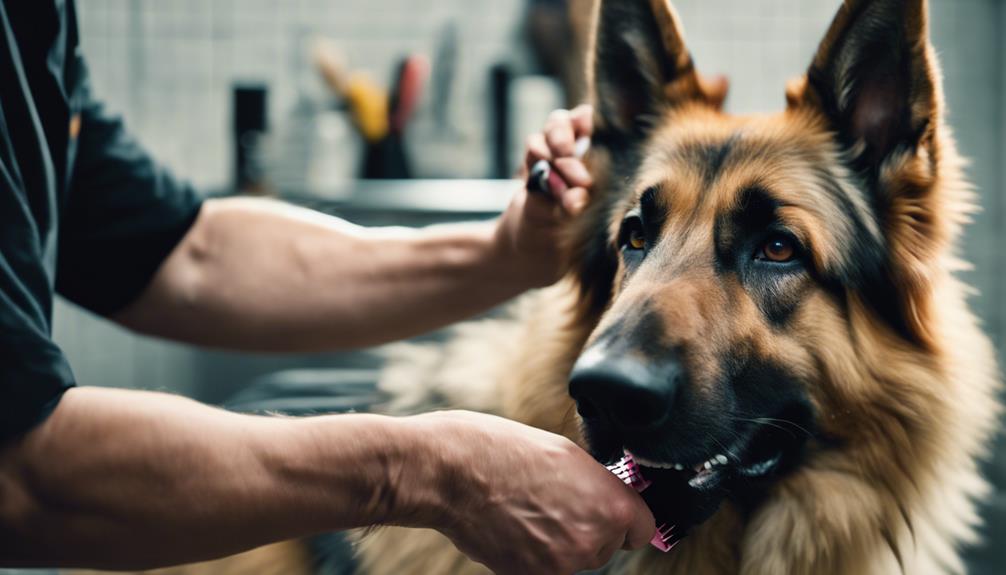
Regular and thorough grooming practices are essential for maintaining the health and quality of the DDR German Shepherd’s thick double coat. These dogs require daily brushing to manage shedding effectively. Regular grooming not only keeps their coat looking its best but also helps prevent mats or tangles from forming. Bathing your DDR German Shepherd every few months using a dog-specific shampoo is crucial to maintain the quality of their coat and keep it clean. Additionally, trimming their nails regularly is important to prevent overgrowth, which can lead to discomfort and potential health issues. Cleaning their ears is also essential to prevent infections and maintain overall hygiene.
| Grooming Needs | Description |
|---|---|
| Brushing | Daily brushing to manage shedding and prevent matting. |
| Bathing | Bathing every few months with dog-specific shampoo. |
| Nail Trimming | Regular nail trims to prevent overgrowth and discomfort. |
| Ear Cleaning | Cleaning their ears to prevent infections and maintain hygiene. |
| Coat Inspection | Regularly check for any signs of skin issues or parasites. |
Male Vs. Female Differences
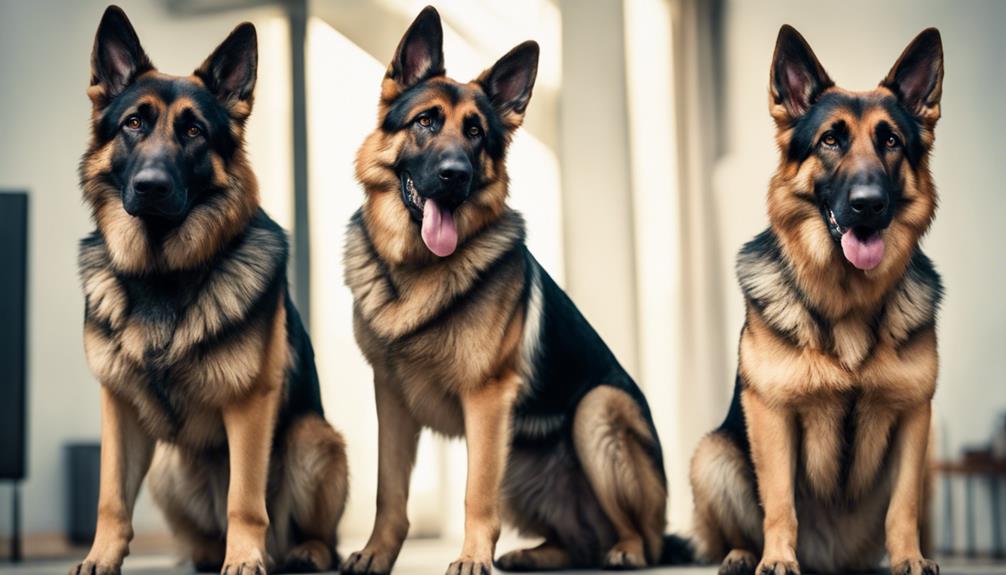
To understand the distinctions between male and female DDR German Shepherds, it is imperative to recognize the specific physical and behavioral variances that exist within this breed. When comparing male DDR Shepherds to their female counterparts, there are noticeable differences in weight and height:
- Male DDR Shepherds: Typically weigh around 88 pounds and have a height range of 24-26 inches.
- Female DDR Shepherds: Usually weigh around 70 pounds and are slightly smaller in height, ranging from 22-24 inches.
In terms of behavior, female DDR Shepherds may exhibit more maternal instincts, leading them to be nurturing towards other pets or family members. On the other hand, males might display more dominant behaviors and protective instincts. Due to their potentially stronger territorial instincts, male DDR Shepherds may require more assertive leadership and training to ensure their behaviors are managed effectively.
Understanding these differences can help potential DDR German Shepherd owners choose the gender that aligns best with their lifestyle and training capabilities.
Unique Traits and Abilities
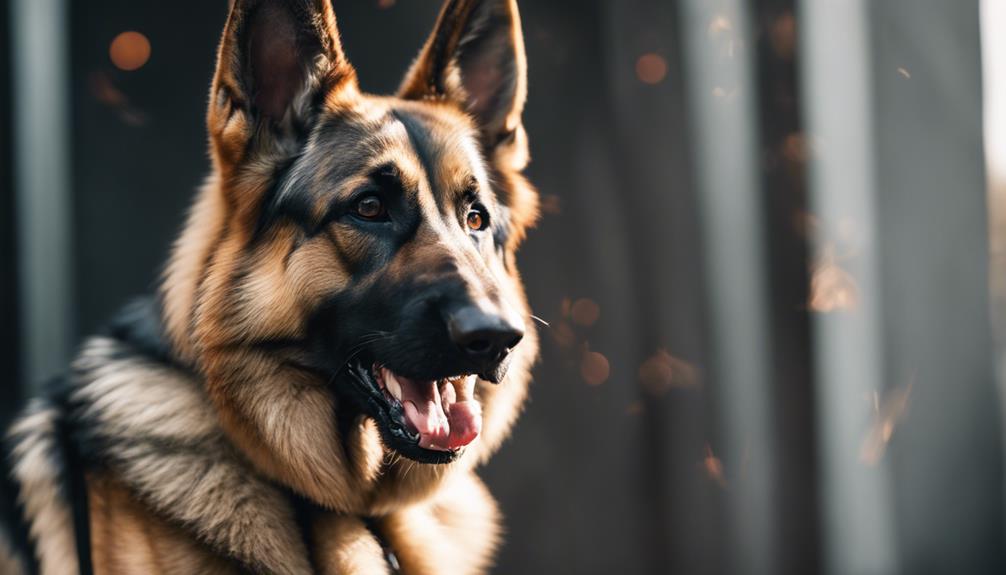
DDR German Shepherds showcase distinctive physical characteristics and behavioral traits that set them apart from other breeds. Known for their larger heads, broad shoulders, deep chests, and dark coats, these dogs possess a unique appearance that commands attention. In terms of behavior, DDR German Shepherds exhibit a medium prey drive and medium-high threshold, making them excellent guard dogs. Their natural guarding instincts are evident through their high pack drive and their ability to form strong bonds with their owners. This makes them not only loyal companions but also reliable protectors.
Due to their breeding history, DDR German Shepherds may display more traditional working dog traits compared to other German Shepherd lines. Careful breeding is crucial to maintain nerve strength and working ability in these dogs, ensuring they remain true to their original purpose. Their intelligence, loyalty, and trainability make them versatile and effective in various roles, from family pets to working dogs.
Considerations Before Getting a DDR German Shepherd

Before acquiring a DDR German Shepherd, it is essential to thoroughly consider several key factors to ensure the well-being and suitability of this breed for your lifestyle. When thinking about getting a DDR German Shepherd, keep in mind the following:
- Daily Training and Exercise: German Shepherds, especially those from working lines like DDR, require mental stimulation and physical activity to stay healthy and happy.
- Reputable Breeders: Ensure you source your DDR German Shepherd from reputable breeders who prioritize the health and genetic quality of the dogs.
- Space Requirements: DDR German Shepherds are active and energetic dogs that need ample space to move around and play.
- Grooming Needs: The DDR German Shepherd’s double coat requires regular grooming to prevent matting and keep the coat in good condition.
Additionally, it’s crucial to prepare for potential health issues that are common in the German Shepherd breed, such as hip dysplasia and degenerative myelopathy. By considering these factors before bringing a DDR German Shepherd into your home, you can ensure a positive experience for both you and your new canine companion.
Frequently Asked Questions
What Is a DDR German Shepherd Breed?
A DDR German Shepherd breed is a canine with distinctive traits, including larger heads, broad chests, and thick coats of black or sable colors. They exhibit strong guarding instincts, loyalty, and intelligence, requiring proper training, socialization, and care.
What Does DDR Stand for in German Shepherd?
DDR stands for Deutsche Demokratische Republik in the context of German Shepherds. Originating from East Germany, DDR Shepherds were bred for military work. They are known for their intelligence, loyalty, and protective nature. Proper training and exercise are crucial for their well-being.
How Do I Know What Breed My German Shepherd Is?
To identify your German Shepherd’s breed, examine coat color variations, health concerns, temperament traits, and training techniques. Key indicators include physical characteristics, behavior patterns, and lineage. Consult experts for guidance on breed identification.
What Is the Difference Between East German and West German Shepherds?
When comparing East and West German Shepherds, you’ll notice distinct characteristics. East German Shepherds, bred for military service, have robust builds and loyal temperaments. In contrast, West German Shepherds excel in versatility, ideal for various dog sports.
Conclusion
In conclusion, owning a DDR German Shepherd requires dedication, patience, and understanding of their unique characteristics. These loyal and protective dogs have a rich history and impressive abilities that make them stand out from other breeds. Remember, like a well-oiled machine, with proper training and care, your DDR German Shepherd will be a valuable asset and a steadfast companion in your life.
